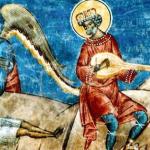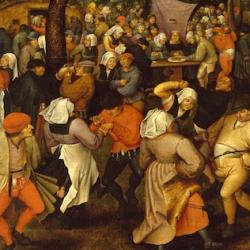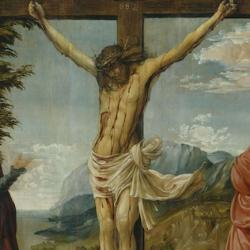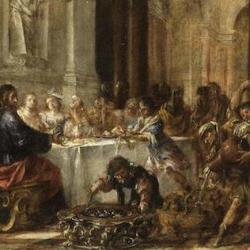The following is an excerpt from my commentary on 1-3 John, From Behind the Veil.
The chapter division in our Bibles does not follow the flow of John’s argument in 1 John, which slips past the end of chapter 1 and flows into the beginning of chapter 2. The first verses of chapter 2 deal with sin, the topic in 1:8-10. The word “sin” is first used in the letter at the end of 1:7, and then used another seven times in 1:8-2:2. The noun or verb “sin” occurs another twenty or so times in the letter, but this cluster of eight uses marks this as a distinct unit.
Further, John mentions the light/darkness contrast at the beginning and end of this section (1:5-7; 2:8b-11), again framing these verses as a distinct paragraph. The word “light” is used six times in 1 John, and these references are clustered in 1:5-7 and 2:8-10. “Darkness” is also used six times, and its distribution is virtually the same (2x in 1:5-6, 4x in 2:8-11).
John’s five uses of “walk” are distributed in a similar fashion. Three appear at the beginning and end of this section – twice in 1:6-7, once in 2:11. Thus, along with the light/darkness contrast, “walk” frames this section. The other two uses of “walk” in 1 John are found at the center of this section (2:6), so that the thematic ends of the section meet in the middle.
This section is chiastically arranged:
A. Light and darkness, 1:5-7.
B. Sin and forgiveness, 1:8-2:2.
C. Keeping the commandments, 2:3-5.
D. Walk as He walked, 2:6.
C’. The new commandment, 2:7-8.
A’. Light and darkness, 2:9-11.
The fact that there is no section on “sin” corresponding to “B” is intriguing, since all the other sections match so neatly. Perhaps the “hatred for the brethren” in 2:9, 11 matches “sin” in 1:8-2:2, but the word “sin” is not used after 2:2, and John’s treatment of hatred is embedded in a section using the imagery of light and darkness from 1:5-7.
1 John 1:5-2:11 structurally symbolizes the absence of sin in the life of the believer. Sin is wiped from the text as it is cleansed when we confess.
Several times, John moves from one topic to another with “hook words,” a word used at the end of one section that becomes the main theme of the next section (“sin” in 1:7-8; “darkness/light” in 2:8-9). John’s use of direct address (“My little children,” 2:1; “Beloved,” 2:7) also marks off new sections. Though 1:7b (or 1:8)-2:2 forms a distinct unit, it splits in two with the direct address, “My little children” (2:1). 2:1 and 2:7 are parallel not only because both begin with an affectionate direct address to the audience, but also because in both John declares his intention for writing: “I write that you may not sin” (2:1) and “Not a new commandment I write to you” (2:7).
God is Light
John passes on a message that he heard from Jesus, the message that God is Light, and in Him is no darkness at all (1:5). It naturally follows that if we are going to have fellowship with the God who is light, we must walk in the light. We have already examined the temporal symbolism of darkness and light in chapter 1, but there is more to say.
First, light is associated with life. Light is the first sign of life in the formless void of the original creation, and God has made the world so that without light, everything dies. Plants wither in darkness, and human beings need light to be healthy.
In several places, the Bible speaks of the “light of life” (Job 33:30; John 8:12), describes the grave as a place of darkness as well as death (Job 33:30), and refers to stillborn or aborted children as those who “never saw light” (Job 3:16). God is Light, and as such is the source of life (Psalm 4; 56).
Second, the God who shone at the creation sheds light is at the exodus, when Israel travels through the darkness of night but has their way illumined by the light of God’s pillar. Yahweh’s glory lightens the way for Israel through a dark world (Exodus 13:21; 14:20), and the image of Yahweh’s light as a guide for His people is picked up in various Psalms (Psalm 18:28; 443; 89:15; 112:4; 119:105).
To say that God is light is to say that He guides His people through the darkness of death and a death-filled world. John appears to have this exodus story in mind: He not only talks about God as Light, but talks about “walking” in the light, as Israel did, and about the “darkness” without light that makes people stumble. He could well be describing the “fall” of thousands of Israelites in the wilderness.
Third, light exposes. Things done in darkness are unknown until they are illuminated, until light shines. According to Psalm 90:8, Yahweh places “our iniquities before You, our secret sins in the light of Your presence.” To say that God is light is to say that He is the Judge, shining into the shadows and bringing secret things to light. Without light, no one can see, and sight in Scripture is the sense associated with passing judgment.
Judgment may seem opposed to life, but the Bible teaches the opposite. God the Light shines to expose and judges, and thereby to bring everything to new life.
We should put all these particular associations in a larger biblical perspective. The world begins in darkness. When God creates light, He divides darkness and light and organizes them into a pattern of day and night. Each day of creation brings further light, more glory.
Throughout history, light and darkness alternate, but someday this cycle will end and there will be no more night (Revelation 21:25; 22:5). The world moves from darkness, to alternation of darkness and light, to absolute eternal light. The God who is Light will be fully revealed only at the end of all things. All that Light means is fully realized only at the consummation. In the future, the fullness of light brings the fullness of life, the full and final judgment, the clarity of climactic revelation. In the end, the Light that has led us on our walk will bring us to our destination.
In short, the Light that God is the light of the consummation. Light is eschatological, and to say God is light is to say that God is the God of the future. He already is, and has always been, the fullness of life. Father, Son and Spirit know, and are known, fully to one another. There are no secret dark corners within Him, within them – all is open. To say God is light is to say that God has already, eternally arrived at the consummation toward which creation is moving.
This helps us understand what John means by walking in light. To walk in the light is to walk according to the future Light of the new creation, the new creation that has already begun in the incarnation of the Word of life. To walk in the light means to walk in hope; to walk in the light is to recognize that this world of mixed darkness and light is temporary; to walk in the light is to set our minds on things ahead, on the world without night that will someday dawn.
“Darkness” is the evening of history, the Old Covenant, while “light” is the day of the Lord that comes when the Eternal Light takes flesh (cf. John 1:6-9). The New Covenant is a covenant of light because with it the final age, the age to come, radiates into this age.
How is the Old Covenant a covenant of evening that yields to the daytime of the New? Israel was not, to be sure, in utter darkness, any more than night is utterly dark. The moon brings light to the night, and so do the stars. Israel’s history took place in the night of the world’s history, but Israel had the light of Torah, the light of God’s presence, the moonlight of the temple.
Yet, the revelation in the Old Covenant was partial and incomplete compared with the sunrise of the Son (cf. Malachi 4:2). God spoke to Israel in many ways and in many times, in many portions and in many ways in the Old Testament, but these are all flickers of light rather than full day (cf. Hebrews 1:1-2). Now that the Son has come, He has spoken His final word, a word that cannot be surpassed. He is Light come into the world.
In the Old Covenant, the God of Light dwelt with Israel, but He dwelt behind dark goat’s hair tent curtains, veils, doors. Yahweh of Hosts was inaccessible to Israel – only the High Priest once a year went into the Most Holy Place to sprinkle blood, and even He did not see the Light of God in any full way. He had to scurry out too quickly to bathe in the light. The Old Covenant was a covenant of veils, which separated the light of God’s glory from the people.
With the new covenant, the veil is removed and the full light of God shines. The God of Light, the God who is light, has emerged from hiding and has come among us. As John says, the message of the gospel is that God is Light. He has made Himself known as He was not known before. The gospel announces that the God who is light has stepped from behind the veil, and the whole world is flooded with His light. And the earth shall be full of the glory of the Lord.
Not only revelation, but life itself was incomplete in the Old Covenant. Israel had life with Yahweh, but Israel did not yet have the fullness of the Risen Son and His Spirit; they were not incorporated by the tangible Risen Word of Life into the eternal life of the God who is light. Jesus came to give life, and to give it abundantly.
Not only life and revelation, but judgment was partial in the Old Testament, because Light had not yet dawned. Under the Old Covenant, the sins of men are were hidden, covered over by the dark of night, covered within Israel by the blood of bulls and goats.
During the times of ignorance, Paul tells the Athenians, God overlooked sin, but now that light has come, He is declaring that all men everywhere should repent (Acts 17:30). In generations gone by, God permitted the nations to go their own ways (Acts 14:16). Before, “in the forbearance of God He passed over the sins previously committed” (Romans 3:25). No longer. Now the new has come, and the times of ignorance are at an end. There is no place to hide, no escape from the penetrating glance of the Judge of earth.
Still people try. Light has dawned, and yet some people stumble around as if it were night (2:10-11). Those who “walk in darkness” are those who continue to live according to the patterns of the Old Creation, those who continue to maintain the distinctions of the law, or continue to treat God as if He were still hidden behind the veil of the tabernacle, or think they can get away with excuses of ignorance.
In John’s immediate situation, Judaizers are those who “walk in darkness” and “hate their brothers” by re-erecting holiness and purity laws that divide Jew from Jew and Jew from Gentile. Of course, the light/dark contrast has a broader application. Even if we are not tempted to keep Jewish dietary laws, we can walk in darkness by despising Christian brothers.
Being in the light that is the life of the new covenant requires more than a profession of faith in Jesus. Several times, John contrasts what people say with what is actually the case (1:6-7; 2:10). We do not have fellowship with Him merely by saying we have fellowship with Him. We must not only say we have fellowship with Light, but must actually walk in the Light, especially by living in fellowship and love with our brothers in the church.
God is light, and His light shines into and through our brothers. We cannot love the light that is God unless we love His light as it shines in our Christian brothers. A profession of fellowship and faith might be falsified by the way we actually walk. If we say we are of the light but continue to live in darkness, we are liars (1:6).
[1] See John Breck, The Structure of Biblical Language (2d ed.; Crestwood, NY: St. Vladimir’s Seminary Press, 2008).












